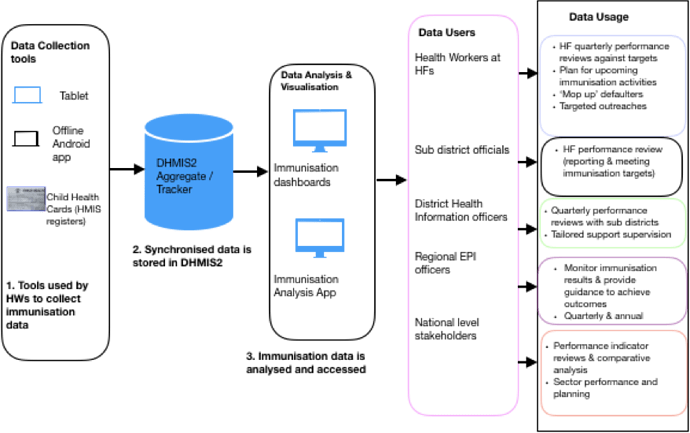DHIS2 has been successfully used in Ghana to support the country’s immunisation efforts. HealthEnabled in collaboration with Gavi, The Vaccine Alliance, WHO, and the University of Olso worked with the Ghana Health Service to document their experience. The Ghana DHIS2 & Immunisation Country Case Study presents Ghana’s deployment and scale up of the DHIS2 immunisation applications including the e-Tracker and Immunisation Dashboards and the effective transition from multiple immunisation data systems to DHIS2. It highlights the country’s achievements, challenges and lessons learned with the aim of helping other countries to learn from their experience. This case study contributes to a broader effort aimed at strengthening and packaging DHIS2 for more effective adoption within national immunisation efforts across settings based on use cases and functionality.
Understanding Ghana’s data needs and direction was critical in the country’s decision to transition from multiple systems to DHMIS2. DVDMT was used by the EPI programme to report to WHO after manually populating the monthly EPI vaccination reports. The same report was being routinely entered into DHIS2. This led to double reporting and duplication of efforts and led to the integration of these systems. The integration process was successfully completed in three phases with Ghana Health Service playing a strong leadership role and providing all the required guidance on data standards and the overall reporting requirements and processes.
Ghana started implementing the e-Tracker in 2016 with the aim of increasing timely completion of immunisation and reduced under-immunisation of children. It has since been fully deployed within four regions and partially in three regions across the country. Using the approved standard operating procedures that guide various health programs on how to have their indicators tracked within DHMIS2, the EPI team developed a set of indicators that were approved and integrated within the Child Health Register that forms the basis for data collection at the health facility level. Data is collected using an offline Android App installed on tablets. Immunisation dashboards at the national, district and sub district levels are used to regularly display data on indicators that are being tracked with the Immunisation Analysis App. This has been configured but not yet rolled out at the regional level due to limited funds to strengthen the capacities of regional EPI Coordinators and managers to be able to use it.
Notable achievements from using the DHIS2 for immunisation in Ghana have manifested from the use of data at all levels as seen in the figure below.
Despite the achievements, Ghana still faces a number of challenges throughout the implementation of DHIS2 Immunisation applications. These include among others, internet connectivity, inconsistencies in data completeness and accuracy from some facilities, health work overload and high staff turnover at the health facility level.
Implementation of the DHIS2 e-Tracker and dashboards in Ghana has the potential to contribute to the attainment of immunisation outcomes. Health workers are committed to capturing data alongside delivering immunisation services. Devices are provided to some health facilities to ease data capture and submission. Trainings are conducted with regular support from the district and sub district to health facilities to ensure effective implementation. This work has highlighted some recommendations for future deployment and scaleup including regular use of health facility WhatsApp groups for public and private facilities to improve data quality, completeness and accuracy; the need for research to link the use of DHIS2 to immunisation outcomes; internet connectivity solutions; integration of systems to maximize the benefits of DHIS2 for immunisation; sustainable funding and support for training and retraining of health facility workforce.
Use of DHIS2 immunisation applications in Ghana has facilitated the availability of good quality immunisation data that has been effectively used for decision making, planning, tracking of defaulters and performance reviews at various levels. To fully realise the benefits of the DHIS2 Immunisation Apps, the identified challenges need to be addressed.
